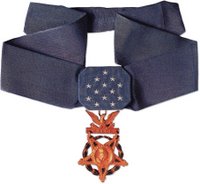Flying Officer, Royal Air Force; 12 Squadron
Born: 28 June 1918, Ballinacor, County Wicklow, Ireland
Died: 12 May 1940, near Maastricht, The Netherlands
THOMAS GRAY
Sergeant, Royal Air Force; 12 Squadron
Born: 17 May 1914, Devizes, Wiltshire
Died: 12 May 1940, near Maastricht, The Netherlands
 Joint Citation: Flying Officer Garland was the pilot and Sergeant Gray the observer of the leading aircraft of a formation of five aircraft that attacked a bridge over the Albert Canal which had not been destroyed and was allowing the enemy to advance into Belgium. All the air crews of the squadron concerned volunteered for the operation and, after five crews had been selected by drawing lots, the attack was delivered at low altitude against this vital target. Orders were issued that this bridge was to be destroyed at all costs. As had been anticipated, exceptionally intense machine gun and anti-aircraft fire was encountered, and the bridge area was heavily protected by enemy fighters. In spite of this the formation successfully delivered a dive bombing attack from the lowest practicable altitude and British fighters in the vicinity reported that the target was obscured by the bombs bursting on it and in its vicinity. Only one aircraft returned from this mission out of the five concerned. The pilot of this aircraft reports that in addition to the extremely heavy antiaircraft fire, through which our aircraft dived to attack the objective, they were also attacked by a large number of enemy fighters after they had released their bombs on the target. Much of the success of this vital operation must be attributed to the formation leader, Flying Officer Garland, and to the coolness and resource of Sergeant Gray, who navigated Flying Officer Garland's aircraft under most difficult conditions in such a manner that the whole formation was able successfully to attack the target in spite of subsequent heavy losses. Flying Officer Garland and Sergeant Gray unfortunately failed to return from the mission.
Joint Citation: Flying Officer Garland was the pilot and Sergeant Gray the observer of the leading aircraft of a formation of five aircraft that attacked a bridge over the Albert Canal which had not been destroyed and was allowing the enemy to advance into Belgium. All the air crews of the squadron concerned volunteered for the operation and, after five crews had been selected by drawing lots, the attack was delivered at low altitude against this vital target. Orders were issued that this bridge was to be destroyed at all costs. As had been anticipated, exceptionally intense machine gun and anti-aircraft fire was encountered, and the bridge area was heavily protected by enemy fighters. In spite of this the formation successfully delivered a dive bombing attack from the lowest practicable altitude and British fighters in the vicinity reported that the target was obscured by the bombs bursting on it and in its vicinity. Only one aircraft returned from this mission out of the five concerned. The pilot of this aircraft reports that in addition to the extremely heavy antiaircraft fire, through which our aircraft dived to attack the objective, they were also attacked by a large number of enemy fighters after they had released their bombs on the target. Much of the success of this vital operation must be attributed to the formation leader, Flying Officer Garland, and to the coolness and resource of Sergeant Gray, who navigated Flying Officer Garland's aircraft under most difficult conditions in such a manner that the whole formation was able successfully to attack the target in spite of subsequent heavy losses. Flying Officer Garland and Sergeant Gray unfortunately failed to return from the mission.[London Gazette issue 34870 dated 11 Jun 1940, published 11 Jun 1940.]














